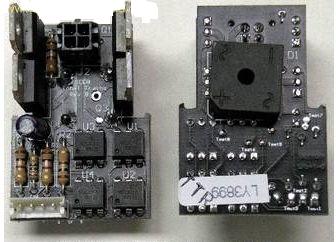I'm making my own driver based on this page:http://www.tuveson.com/DriverBoard/TMCCBoardMain.htm
The thing is, I don't see how it could work. This circuit I believe drives the optos based on pwm'ing, for the forward direction, pins 18 and 20. But when I scope my R2LC in conventional mode, I only see a 20% duty cycle between these pins.
Based on that, seems to me that I need to reference pins 18 and 16 (reverse) to ground, not pin 20 - therefore getting an 80% duty cycle. But I'm sure this guy knew what he was doing, and in any case there is no ground reference on that pinout.
His schematic is pretty old. Have I (oh please!) discovered the mysterious difference between the R2LC "rev 08" - which is what I'm working with - and it's predecessors? And in that happy circumstance, then what pin should I reference 16 and 18 to?
But that leaves another question: When not driving, are 16 and 18 tristated, because if they actually "rest" at 5v then my circuit is so not going to work. (But then I can't imagine a sane circuit that would.)
Help? ![]()



